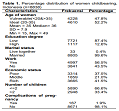Factors analysis of unwanted pregnancies among women childbearing age in Indonesia: analysis of demographic and health survey data in 2017

Downloads
Background: Unwanted pregnancies were one of the serious threats to human development around the world. This analysis identifies factors associated with unwanted pregnancies, including intrapersonal, interpersonal, and institutional health services.
Objective: We analyzed the extent of unwanted pregnancies and how they predict factors related to Indonesia's unwanted pregnancies.
Methods: We analyzed data from the Indonesian Demographic and Health Survey (IDHS) in 2017. Descriptive statistics on the prevalence of unwanted pregnancies and correlated factors. Multiple logistic regression was used to examine the association between intrapersonal factors, interpersonal factors, and community factors with unwanted pregnancies.
Results: Participants reported that their most recent was 83.8% indicated a desired pregnancy and 16.2% were unwanted. Multivariate analysis shows the age of the woman (OR=1.37), economic status (OR=1.05), number of children (OR=1.47), contraception failure (OR=0.78), and health worker intervention (OR=1.27) was found to significantly increase the risk of unwanted pregnancy (p<0.05). The number of children is the most substantial factor in unwanted pregnancy among women childbearing in Indonesia.
Conclusions: Nearly a fifth of pregnancies among vulnerable women in Indonesia are unwanted pregnancies. WomenEnglish translation. should plan pregnancy according to the target number of children desired with a partner.Authors retain copyright and grant the journal right of first publication with the work simultaneously licensed under a Creative Commons Attribution-NonCommercial 4.0 International License that allows others to share the work with an acknowledgement of the work's authorship and initial publication in this journal.
Authors are able to enter into separate, additional contractual arrangements for the non-exclusive distribution of the journal's published version of the work (e.g., post it to an institutional repository or publish it in a book), with an acknowledgement of its initial publication in this journal.
Authors are permitted and encouraged to post their work online (e.g., in institutional repositories or on their website) prior to and during the submission process, as it can lead to productive exchanges, as well as earlier and greater citation of published work (See The Effect of Open Access).

This work is licensed under a Creative Commons Attribution-NonCommercial 4.0 International License.











